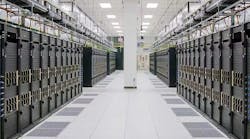You don’t hear the “server farm” jokes much anymore. Nine years after its first major data center project was announced, Iowa has attracted one of the world’s largest clusters of hyperscale data centers. The state’s cloud campuses have attracted nearly $7 billion in investment, creating thousands of construction jobs and boosting the state’s infrastructure.
The latest sign of Iowa’s central place in cloud geography came last week, when it was revealed that Microsoft will invest up to $2 billion in a new data center in West Des Moines, where it already operates two huge data center campuses. Local officials said “Project Osmium” would boost Microsoft’s total investment in West Des Moines to nearly $3.5 billion.
“Project Osmium will be the largest data center deployment Microsoft has ever built in the United States,” said West Des Moines Mayor Steve Gaer.
Microsoft isn’t alone. Iowa is already home to Google’s largest data center campus in Council Bluffs, while Facebook is currently building the last of three huge data center buildings in Altoona.
“We have made a name for ourselves in Iowa in the data center world,” Gov. Terry Branstad said.
The rapid growth of cloud computing has spurred a building boom for the major Internet platforms, as Google, Microsoft, Amazon and Facebook are all super-sizing their cloud campuses to add data center capacity.
Cloud campuses are where these companies concentrate massive amounts of computing power in multiple data center facilities. These data center hubs enable companies to rapidly add cloud capacity and electric power, creating economies of scale as more workloads migrate into these massive server farms.
Iowa has benefited from a confluence of factors that make it attractive to data centers, including its location, which provides low latency to deliver online services to the center of the country. The state has relatively low costs for land and utility power, and lower exposure to natural disasters than many areas of the nation, with low risk from hurricanes and earthquakes.
Data center projects also benefit from inventive programs passed by the Iowa legislature in 2009, which offer sales and use tax refunds for spending on servers, power and cooling infrastructure, racks and cabling and electric power. Municipal governments can also offer exemptions on property taxes to attract data center projects.
Microsoft
Microsoft is both building and buying infrastructure to support the rapid growth of its Azure cloud business, which provides instant capacity for companies to run applications in other companies’ data centers.
Revenue from Azure rose more than 100 percent in the most recent quarter, while revenue from Office 365 (the subscription version of the desktop Office software) rose 54 percent from commercial customers and 19 percent from consumers.
Microsoft operates more than a million servers around the world, and is on track to have 28 Azure regions online by the end of 2016.
Microsoft’s new data center will be built on 200 acres of land spanning Warren County and 40 acres in Madison County. Plans call for four phases of construction, with data centers between 256,000 and 583,200 square feet in size, for a total planned footprint of 1.7 million square feet.
A satellite view of Microsoft’s “Project Alluvion” data center campus in West Des Moines in 2015. The company may build as many as 16 data center buildings on the 154 acre property. (Image: Iowa Geographic Map Server)
Project Osmium is Microsoft’s third campus in the West Des Moines area. Why separate campuses, instead of one large campus? City officials say Microsoft is spreading out its risk out of concern about tornadoes, seeking to limit potential disaster damage from any single storm. The three sites are between five and seven miles apart.
The newest campus continues Microsoft’s massive expansion of its data center infrastructure, which has accelerated this year. Project Osmium represents the “build” side of the equation.
On the “buy” front, Microsoft has signed massive leases for data center space in three key markets, according to real estate reports. The company has reserved 47 megawatts of space with deals in northern Virginia, Silicon Valley and San Antonio. Recent reports suggest Microsoft may be seeking to lease an additional 25 acres in both the Northern Virginia and Chicago markets.
“We have invested heavily to build share, expand geographically, and ensure world-class support and reliability for our commercial customers,” said Microsoft CEO Satya Nadella. “Going forward, we expect those investments to provide benefits of scale.”
The newest project illustrates the potential benefit data centers can provide for the local community. Project Osmium will include infrastructure upgrades including new power lines, streets, water lines and sanitary sewer lines that will help accelerate the development of over 5,000 acres of land in northern Warren and Madison counties – including 10 miles of new roadway.
“Today’s announcement is a big win for our region as it further positions Central Iowa as a national data center hub,” said Jay Byers, CEO of the Greater Des Moines Partnership.
Google was the first cloud builder to arrive in Iowa, building its first data center in Council Bluffs in 2007. It soon acquired a larger plot of land on the outskirts of town for a larger cloud campus. Google has already invested $1.5 billion on infrastructure in Iowa, and has plans to spend an additional $1 billion building data centers in the state.
Joe Kava, Vice President for Data Center Operations at Google, says the company’s multi-building project in Council Bluffs “is the world’s largest data center campus. Each of these building pads is more than a third of a mile long, with multi-story data centers.”
Google has lots of land in Iowa. To boost its cloud capacity, Google is going vertical with its data center design, shifting from a single-story design to four-story data centers.
“In many of our campuses we’ve been doing multi-story buildings,” said Kava. “Our most recent building in Iowa is four stories.”
The new four-story data center at the Google campus in Council Bluffs, Iowa towers above the one and two-story data centers seen at left. (Photo: Google)
“It’s a natural evolution of our campus strategy.” said Kava. “If you’re looking to preserve the amount of expansion on a campus, you look to densify and get the most out of every square foot, and that means multi-story.”
“The movement to cloud is really accelerating,” said Kava. “We know that long-term capacity planning is very difficult. Everyone struggles with it, and we have been growing and growing.”
Facebook’s project in Altoona has seen the most aggressive construction schedule of any of the company’s data center campuses. Just three years after announcing its plans for a server farm in Iowa, Facebook has completed two massive data centers and begun work on a third. Each building costs about $300 million to build and fill with servers and networking equipment, placing Facebook’s investment above $900 million.
Iowa Governor Terry Branstad (center) tours the Facebook data center in Altoona in June 2016. (Image: Facebook)
Altoona was the first location where Facebook committed to a third data center, which is likely a reflection of Iowa’s favorable environment.
One of the factors that worked in Iowa’s favor was the availability of renewable wind energy. Facebook worked with Iowa utility MidAmerican Energy and wind farm developer RPM Access to fund the construction of a wind turbine project that would generate 138 megawatts of new wind energy capacity to the Iowa grid – enough to more than offset the power Facebook uses on its Altoona campus.
“When we settled on Altoona as the location for our fourth data center, one of the deciding factors was the opportunity to help develop a new wind project in the state,” wrote Vincent Van Son, Facebook’s Data Center Energy Manager, in unveiling the investment. “The project brings additional investment and jobs to the region, and in effect it makes it possible, on an annualized basis, for 100% of our energy needs to be met entirely with one of Iowa’s most abundant renewable resources.”






